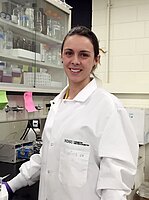Isolation and Identification of Endoxifen Bacterial Degraders in Wastewater

Marina Ariño Martin is a Master of Science student in Environmental and Conservation Sciences program at North Dakota State University. She holds a Bachelor of Science degree in Biology from the University of Malaga, Spain. Her thesis research is on the isolation and identification of bacteria responsible for endoxifen biodegradation in wastewater.
Email: marina.arinomartin@ndsu.edu
Phone: 954-294-3737
Fellow: Marina Ariño Martin
Advisor: Eakalak Khan, Ph.D., P.E., Professor, Department of Civil and Environmental Engineering, North Dakota State University
Co-Advisor: John M. McEvoy, Ph.D., Professor, Department of Veterinary and Microbiological Sciences, North Dakota State University.
Degree Progress: M.S. in Environmental and Conservation Sciences expected in Spring 2017.
Isolation and Identification of Endoxifen Bacterial Degraders in Wastewater
Endoxifen is an active metabolite responsible for the effectiveness of tamoxifen, a chemotherapeutic drug widely used for endocrine responsive breast cancer and chemopreventive longterm treatment. Despite the fact that tamoxifen and endoxifen are effective treatments for breast cancer, they present possible consequences on the environment. Tamoxifen and endoxifen are not completely metabolized in human body and are excreted. As a result, they are released to the water environment via wastewater treatment plants. The presence of tamoxifen in the environment produces negative effects due to its antiestrogenic activity. Because endoxifen is 30-100 times more potent than tamoxifen itself, and because endoxifen also presents antiestrogenic activity, its presence in the environment could result in toxic effects on aquatic lives. Therefore, the detection and degradation of endoxifen in wastewater are necessary to avoid the possible effects. The main purpose of this study is to examine endoxifen biodegradation by bacteria in wastewater. These bacteria will be isolated and identified. The growth of isolated bacteria, exposed to endoxifen as a sole carbon source or as a sole carbon and nitrogen source, will be monitored and the biodegradation of endoxifen will be observed. This study will also determine the concentration of endoxifen in natural water bodies.
Project Objectives:
The aim of this research is to isolate and identify bacteria that play an important role in the biodegradation of endoxifen. Endoxifen will also be examined in wastewater and treated wastewater samples, and surface water and sediment samples from the Red and Missouri rivers, upstream and downstream of the WWTPs.
The proposed research has the following objectives:
- Establish methods to detect and quantify endoxifen;
- Isolate and identify endoxifen bacterial degrader; and
- Determine actual concentrations of endoxifen in wastewater, treated wastewater, surface water and sediment receiving treated wastewater, and surface water and sediment.
Progress:
Bacteria exposed to wastewater with added endoxifen have been isolated. The growth of bacteria individually incubated in mineral media with endoxifen as its sole carbon source, and in basal salt media with endoxifen as its sole carbon and nitrogen source, has shown promising results. Currently, methods to extract and quantify endoxifen are being established. Detection of endoxifen in wastewater and natural water bodies will be conducted as soon as the best analytical method is identified.
Significance:
The research results will show endoxifen levels in wastewater, treated wastewater, surface water, and surface water receiving treated wastewater. The occurrence of endoxifen in these water bodies is likely due to the administration of tamoxifen for cancer treatment by oncological hospitals. The current lack of knowledge about the presence and level of endoxifen in the water environment could lead to unknown toxicological effects on aquatic lives or even humans. The actual concentrations of endoxifen in surface water and surface water sediments that aquatic and bentic lives are exposed to could guide future remediation and toxicological studies. Identification of endoxifen bacteria degraders will lead to a better understanding of the biological techniques needed in order to remove endoxifen in wastewater. The detection of endoxifen will reveal the presence of another emerging micropollutant in the water environment.
Conference/Seminar Presentations:
Marina Ariño Martin, Dhritikshama Roy, John McEvoy, Eakalak Khan. “Isolation and identification of endoxifen bacterial degraders in wastewater”. North Dakota Water Quality Monitoring Conference, March 2016, Bismark, North Dakota. (Poster)

Eakalak Khan
Civil & Environmental Engineering
NDSU

John McEvoy
AES Microbiological Sciences
Office: VanEs 132A
Telephone: 701-231-8530
Email: john.mcevoy@ndsu.edu


